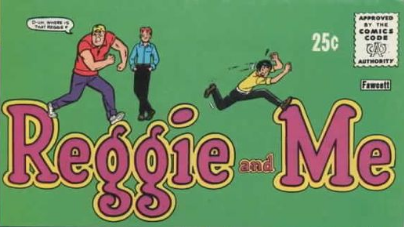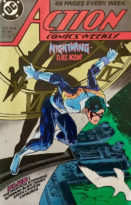
Yesterday, I began my reflection on Reggie and my first “big” project. One of the “tent pole” series of the Chris and Reggie Channel. I had expected it to be a “one and done” piece, however, I found I had a lot more to say about our craft than I thought I would. Today, we will look even deeper into our methodology, and also discuss how quickly our little show, that we figured we’d only spend an hour or two a week working on… became quite a bigger part of both of our lives.
—
Rather than be just two more comics podcasters who lambaste Seduction as being unfounded trash… we took the extra step and, get this… we actually read it. So often, when Seduction comes up in conversation… people can tell you that it was bad for comics, but very few… even those who were purporting to “learn you something” could tell you anything specific. Like Reggie said, we could do better than that.
Also like Reggie said, so long as we can site our sources, and back up what we say… we’re okay. And so, I suggested that we hit up the “ultimate source” for this subject. The one people view as the root cause of the establishment of the Comics Code Authority. We managed to “find” copies of Seduction… and we spent a better part of a week working our way through this book… while filling in our notes in the script.
Here was our “mission statement” for Episode 2:

I know to this point, we’ve been pretty… I don’t want to say “pro-Wertham”, but we haven’t outright dismissed him or run him down. Folks, Seduction of the Innocent… sucks. I can say that as someone who actually put the work in and read it. It sucks, but… it sucks on purpose. It’s not written as a peer-reviewed academic piece… it’s written with very basic vocabulary, and is absolutely loaded with anecdotes.
The inherent “goodness” of Dr. Wertham is something that could be debated. His intelligence, however… I think that’s just something even the most fervent Wertham haters are going to have to accept. This book had a message… and an agenda… and he knew how to cast as wide a net as possible so that his words could be heard.
Thing is… he was hardly the first person to posit that comic books led to juvenile delinquency.
- Sterling North (May, 1940)
- “A National Disgrace (and a Challenge to American Parents)” – Chicago Daily News
- Referred to comics magazines as “a poisonous mushroom growth” and a “violent stimulant” for children
- This article, which might be our “patient zero” would be reprinted in over 40 newspapers and magazines of the day
- Remember, this is just two years after Superman makes his first appearance
- Stanley Kunitz (April, 1941)
- “Libraries, to Arms!” – Wilson Library Bulletin
- Compared comics to violent and narcissistic “Nazi training manuals”. Saw comics as an “aesthetic monstrosity” that stifled development
- John Mason Browne (1948)
- “Seeing Things” – Saturday Review of Literature
- Comics are… “the marijuana of the nursery; the bane of the bassinet; the horror of the house; the curse of the kids; and a threat to the future.”
So, being anti-comic book was sort of “in the ether” back in the day. If you stop and think about it, over time… most forms of entertainment aimed at children wind up getting blamed for delinquency or adaptation of poor habits. Movies, television, music, video games, cartoons… and, of course comic books. So, in a way: this is less anti-comic book (specifically), and more, perhaps looking for answers where there might not be any.
Which brings us back to Wertham.
One of our theories, as it pertained to Seduction… which, I don’t believe we actually included in the show. We wanted to keep the first four parts of this series mostly “editorial-free”. That theory was that, Wertham… in his daily work, might have heard from some children and adolescents that they had adopted some of their maladaptive behaviors from… a comic book.
Remember, we’re up to post-War comics right now. Superheroes were on the wane… replaced by more diverse offerings, including horror and… crime. Among the biggest, were the Biro books from Lev Gleason Productions (Crime Does Not Pay). Those old crime books were a passion of Reggie’s… he really enjoyed them, and even sent me a copy of a Dark Horse book of reprints last year:
There were also the EC books, which had been passed down from Max Gaines to his son Bill. Max’s story is long and involved, but for brevity’s sake… his EC stood for “Educational Comics”. He did not want to be associated with juvenile delinquency… and so, his comics are more literary… and Bible-based. When he passed in a boating accident (1948), his son William took over the biz… renamed EC as “Entertaining Comics”, and started putting out horror, sci-fi, and war books… among others (most with the word Weird in the title).
Now, if you’ve ever delved into psychological research… like, specific psyche research, you would eventually begin to see trends. Trends are important in research, as they lead to best practices… and “established wisdom”. For example, much of the basis of profiling in Forensic Psychology, is predicated on seeing trends and generalizing from past research.
Back to Wertham… and again, this was just a theory we had.
We had the idea that Wertham, upon hearing from a handful of troubled adolescents that their behaviors were do to exposure to comic books… he might have attempted to generalize that to the rest of the young patients he treated. This could/would invite, what we in the biz refer to as “leading questions”. Something the psychology community is all too familiar with.
Take Sybil (1976), for example. A book that became a TV-movie about a woman with Multiple Personality Disorder (as it was referred to at the time… nowadays, it’s Dissociative Identity Disorder). This became something of a phenomenon… and wouldn’t you know it, MPD diagnoses began to skyrocket! Counselors, Psychoanalysts, and Psychologists all wanted their own “Sybil”… and so, “leading questions” were employed to get them.
So, say you’re a kid in 1950… and you just got busted for stealing some candy… or maybe a bike. The strange doctor with the thick accent offers you an “out” by asking if this was something you learned from a comic book. Not knowing how to answer… you say “Maybe”… and that doctor’s eyes light up. You’ve given him what he wants to hear… and so, your punishment suddenly becomes less severe. You have an excuse for your misbehavior… you no longer need to “own” what you did.
Again, this was just our theory… don’t take it as anything more.
Wertham began discussing comic books in a meaningful way, as far as we could tell, in 1948. There are some important quotes here that I’d like to include.
- Colliers Magazine (March 27, 1948):
- “Horror in the Nursery!” by Judith Crist
- “We do not maintain that comic books automatically cause delinquency in every child reader, but we found that comic book reading was a distinct influencing factor in the case of every single delinquent or disturbed child we studied.”
- Studies were provided from Wertham’s own Lafargue Clinic
Classic “correlation does not imply causation” at work here. Wertham cites comics as being a “distinct influencing factor” in every delinquent he studied, while not being an “automatic” cause of behavior. Now, this was the mid-late 1940s… comics were a rather ubiquitous thing, right? It would probably be harder to find a child/adolescent who didn’t read comics. We see this as Wertham sort of “riding the wave” of the comics controversy that was being fomented at the time.
- “The Psychopathology of Comic Books” (1948)
- A symposium delivered by Wertham
- Later Printed in the American Journal of Psychotherapy
- Claims that children might identify with the heroes in the comics… and may project their own problems on to them. If a hero kills a villain, the reader may equate their problems with the villain. If the villain ends up maimed or killed… well…
- “The price being only a few cents apiece, and the distribution national, every city child can, and does, read from ten to a dozen of these pamphlets monthly, an unknown number of times, and then trades them off for others. If there is only one violent picture per page–and there are usually more–every city child who was six years old in 1938 has by now absorbed an absolute minimum of eighteen thousand pictorial beatings, shootings, stranglings, blood-puddles, and torturings-to-death, from comic books alone. The fortification of this visual violence with similar aural violence over the radio daily, and both together in the movies on Saturday, must also be counted in. The effect–and there are those who think it has been a conscious intention–has been to raise up an entire generation of adolescents who have felt, thousands upon thousands of times, all the sensations and emotions of committing murder, except pulling the trigger. And toy guns–advertised in the back pages of the comics–have supplied that.”
This sort of thing might sound a bit familiar to you if you’re play video games. Exposure to violent images… makes you violent. Of course, much of this has been debunked… and yet, anytime there is a violent outburst in society, video games are usually at least mentioned in passing. Perception is reality… no matter how much data flies in the face of it. The narrative is important… I don’t have to remind you, we are talking about the “Boogeyman” here.
- Saturday Review of Literature (May, 1948)
- “The Comics… Very Funny!” by Wertham
- In this piece, which would be reprinted (in part) in Reader’s Digest, Wertham provides anecdotes from his cases at the Lafargue Clinic.
- “I examine a boy of fourteen referred to the clinic for stealing. I ask him: do you think your stealing had anything to do with the comic books? And he answers: “Oh no, in the comics is mostly murder.” This is like the arguments used by experts under subsidy from the comic book industry.”
Well… there’s a leading question right there! The rest of the article is much of the same, however also includes his line-by-line refuting of a list of “Twelve Points in Support of Comic Books”. If I’m remembering right, he doesn’t even really address those points… he more or less just sticks his fingers in his ears and says “No.”
So, we’re almost up to Seduction of the Innocent… but, first, let’s recap a bit. Frederic Wertham didn’t “come out of nowhere”. He was an established and respected member of the psychological and intellectual community. He did a lot of good for society… which is a point we cannot forget. He helped a lot of people who otherwise would have been cast aside. The words he wrote were taken seriously… his symposium was was reprinted in the American Journal of Psychotherapy… a widely respected publication which still comes out four times a year to this very day. His pieces were reprinted in Reader’s Digest… a widely-read publication… even to this very day (it’s the largest paid circulation magazine in the world).
I’ve been writing for about an hour and a half at this point (and we haven’t even started to discuss Seduction yet!)… using the notes we had put together in the Summer of 2016. This is just further evidence of how seriously Reggie and I were taking this project. How far we were willing to go in order to give an actual “fair and balanced” look at an event in comics history that has sadly been lost to a lazy narrative. A narrative that continues to be perpetuated.
We were spending many hours a day together at this point. This was the first time in a long time where I actually “made a friend”. Reggie was working full-time and I was working part-time while a full-time student, which made this “destination research”… rather than “passive research”. We had to make the time for this… waking up extra early, and/or staying up extra late. Maybe pushing aside some of our other responsibilities and/or hobbies. While we never assumed anything we would say might change any perceptions (and ultimately, it didn’t)… we were passionate about getting this “right”.
I had mentioned that this series of episodes was our first “big” project… and would inform much of how we would operate for the next several years… and, upon reflection… man, that’s absolutely true. I feel in the years following this, we both matured as content creators and grew closer as friends and partners. It’s weird… I think back to 2016… which, was only four years ago, and when I picture us… we were kids.
We weren’t. Not by any definition… but, still… that’s what I picture. A couple of kids starting on this monumental (to them) project… that would solidify into an amazing relationship going forward.
I think… that’s all I have in me today… tomorrow, I promise, we’ll actually get into Seduction of the Innocent. I thank you all for reading.







I think that you should take the transcripts of this series of podcasts and turn them into a book. This research deserves to be seen by a larger audience than you ever reached with the podcast.
That could be an idea worth looking into!
It's funny… it's been nearly a half-decade since I ever looked at these scripts, and even though I know we "performed" them back in the day, the amount of hours/work we put into them is quite staggering… I can hardly believe it!